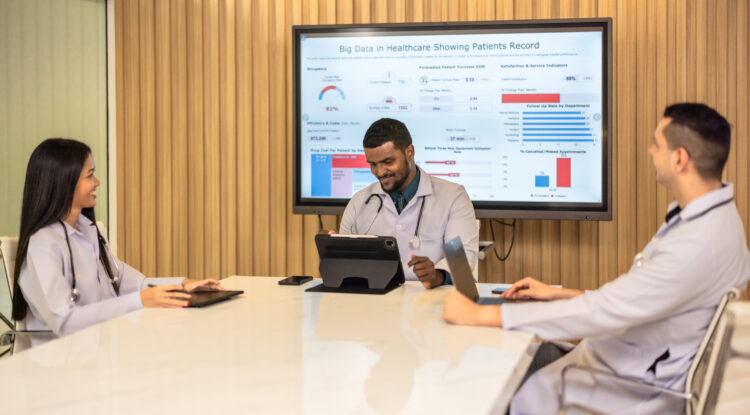Electronic Health Records (EHRs) have reshaped the way healthcare professionals manage and deliver care. These digital repositories of patient information present both challenges and opportunities for maximizing efficiency, improving patient care, and enhancing data security. This guide will delve into various strategies for harnessing the full potential of EHRs while maintaining a user-friendly and secure environment.
Implementing Interoperability
One of the keys to unlocking the true potential of EHRs is achieving interoperability. Interoperability ensures that different information systems can communicate effectively, allowing seamless exchange and interpretation of patient data across various healthcare providers. This feature can facilitate timely and accurate diagnosis, treatment, and coordination of care among practitioners.
Some medical specialties require unique features in their EHR systems to efficiently manage patient data and treatment plans. For example, a psychiatry EHR might include customized templates for mental health assessments and tailored tools for tracking patients’ progress over time. Recognizing the unique needs of specific healthcare specialties can lead to more effective implementation and utilization of EHRs.
Optimizing Data
For EHRs to work optimally, it’s crucial to have standardized data formats and clinical terminologies. Standardization makes it easier for healthcare providers to collaboratively manage patient information and compare outcomes across different institutions. Adopting widely recognized standards, such as Systematized Nomenclature of Medicine – Clinical Terms (SNOMED CT) and Logical Observation Identifiers Names and Codes (LOINC), can ensure uniformity in the way EHRs store and share data.
Protecting patient information has always been vital, but the increased use of EHRs has brought about new security concerns. Implementing a robust strategy that includes regular risk assessments, encryption, strong authentication protocols, and continuous monitoring can safeguard sensitive data from unauthorized access and cyber threats. A well-thought-out backup and recovery plan is also crucial for preventing data loss during unexpected events like system failures and natural disasters.
Engaging Patients
EHRs offer patients the opportunity to access their own health information and become more engaged in their care. Features such as patient portals, telehealth services, and secure messaging can encourage patients to track their progress, communicate with providers, and make informed decisions about their health. Healthcare organizations must also provide patient education materials, offer guidance on portal use, and prioritize addressing patient concerns in order to foster a successful patient-provider relationship.
Streamlining Workflows
EHRs can become powerful tools when integrated effectively into an organization’s workflows. Streamlining processes, such as clinical documentation, order entry, and results retrieval, can help healthcare professionals save time and focus on patients. To accomplish this, healthcare organizations should evaluate their current workflows, identify areas for improvement, and collaborate with EHR vendors to customize features and templates that meet their specific needs.
Information siloes often exist within healthcare settings, with EHRs sometimes contributing to this issue. Overcoming barriers between different departments and care teams ensures that all stakeholders can access relevant patient information and contribute to a patient’s care plan. Integrating EHRs with other health information systems, such as picture archiving and communication systems (PACS) and laboratory information systems (LIS), can help promote a unified approach to patient care.

To build on this notion of integration, healthcare organizations, including those operating in specialized settings such as anatomic pathology, molecular pathology, and veterinary laboratories, should ensure that their LIS and EHR systems work seamlessly together. For instance, in anatomic pathology labs, integrating LIS with EHR systems can streamline the management of complex diagnostic workflows, such as tracking biopsy specimens from collection through analysis to reporting results.
Collaborating with an LIS vendor like NovoPath or other reputable providers could support this integration by enabling automated specimen tracking, improved result turnaround times, and enhanced data accuracy. Such interoperability tends to ensure that providers have timely access to critical diagnostic information, helping healthcare organizations streamline workflows and contribute to better patient care.
Future Developments
As technology continues to evolve, it will enable even more advanced features in EHRs. For example, the integration of wearable devices and Internet of Things (IoT) technology can provide real-time data that can be imported into EHRs to inform clinicians’ decisions. Additionally, the implementation of blockchain technology can enhance data security while improving interoperability between systems. Healthcare organizations should stay informed about these emerging trends and be prepared to adapt and leverage new advancements.
Artificial Intelligence (AI) and machine learning technologies have the potential to revolutionize the use of EHRs. By incorporating AI-driven insights and analytics into clinical decision-making processes, healthcare providers can benefit from enhanced efficiency, more personalized care, and improved patient outcomes. AI-powered tools can analyze vast amounts of data, identify patterns, and predict outcomes, paving the way for proactive care and the early detection of health issues.
Conclusion
By exploring interoperability, data standardization, workflow optimization, patient engagement, and embracing artificial intelligence, healthcare organizations can fully unlock the potential of EHRs. Adopting a proactive and strategic approach in leveraging these digital platforms can ultimately enhance patient care, improve provider efficiency, and safeguard essential health information. The journey towards unlocking the full potential of EHRs will undoubtedly continue in the coming years, as advancements in technology and new requirements within the healthcare landscape shape its evolution.














Leave a Reply